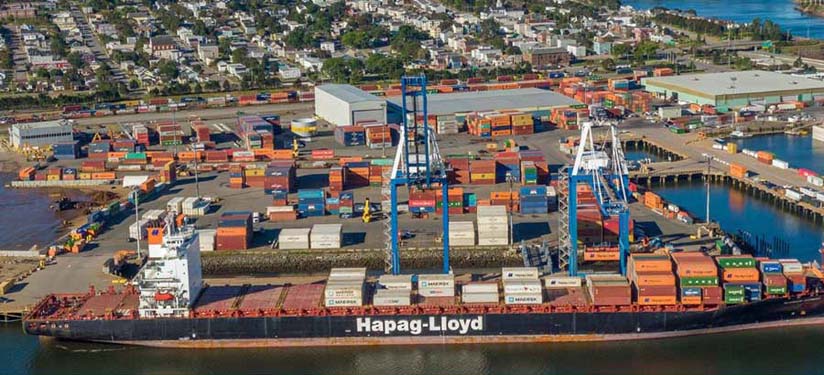
North America - Two East Coast ports are anxiously awaiting the outcome of the bidding war between Canada's two rail giants to create a
continent spanning network in North America.
Both Port of Halifax and Port Saint John are expanding their facilities.
However, the result of the possible acquisition of Kansas City Southern (KCS) by either Canadian Pacific Railway Ltd. (CP) or Canadian National Railway Co.
(CN) could help determine which terminal becomes shippers' preferred gateway to and from Canada's East Coast.
CP recently gained access to Saint John with its purchase of a smaller eastern railway, making the port its East Coast hub and attracting the attention of some
transatlantic shipping lines.
CN also has access to Saint John but is the sole rail provider to the Port of Halifax, which is frequently visited by transatlantic importers and exporters of
container goods such as newsprint, machinery, seafood, and a host of consumer products.
The battle over KCS is widely viewed by observers as an effort to capitalize on the U.S.-Mexico-Canada Agreement (USMCA) because the winner would give its
customers access to rail lines and terminals in all three countries.
It is primarily motivated by the expected increase in onshore freight, but offshore traffic will continue to play an important role, University of Toronto
professor Dimitry Anastakis said.
"You've got a lot of stuff coming in from outside of North America still. So, obviously you'd be integrating, and going from strength to strength because
now you could utilize your existing offshore networks and integrate them into this larger North American network, which would be really
beneficial," Prof. Anastakis said.
The rivalry between the two major Canadian railways, he said, has historically been an East-West one, with CP's main offices in Calgary and CN headquartered in
Montreal.
But with its acquisition of the Central Maine & Quebec (CMQ) railway last June, CP has re-established its presence in the East.
Port Saint John CEO Jim Quinn said this provides "optionality" for those hoping to move cargo through Saint John.
"That's a really significant development. It puts the port back where it used to be in the mid-90s, and for years before that when we were the only
Atlantic port serviced by both of Canada's Class 1 railways," Mr. Quinn said in an interview.
With a $205 million expansion under way, Port Saint John is attracting interest from international shipping lines, such as Hapag-Lloyd, for which credit is
owed largely to CP, Mr. Quinn said, citing the rail provider's "strong emphasis" on making Saint John its eastern hub.
CP committed $90 million to improve the CMQ railway last June and ran its first international container service from Saint John last August.
"We're very, very, excited with the position that CP has taken and everything that they've done coming into Saint John," Mr. Quinn said, adding that
the rail provider is "very well positioned" to extend its footprint.
Port of Halifax has a long-standing relationship with CN that dates back to the beginnings of both organizations, Halifax Port Authority spokesperson Lane
Farguson said.
"CN is our sole rail provider here in Halifax. So, a very, very, important partner and absolutely critical to what we do on the cargo side," Mr.
Farguson said.
CN helps to promote trade growth through the Port of Halifax, he said, and the port will do what it can to support its partner in the proposed merger which,
for the port, means potential for new opportunities to move cargo along the North-South corridor.
The deal wouldn't guarantee more traffic, he said, but it would "open up new markets" for customers.
"In the world of containerized shipping over the last number of years we've seen strategic alliances being formed or mergers amongst the shipping
lines. And it's interesting that now, we're starting to see that amongst the rail lines as well. And really it's about minimizing costs and creating
value," he said.
After the recent completion of a deep-water berth extension and the installation of a mega-crane, Port of Halifax welcomed in September the largest container
cargo vessel to visit a Canadian port at 366 metres long.
It's a 15,000 twenty-foot-equivalent unit (TEU) ship.
The port experienced a 7 percent decrease in container cargo shipments last year amid the pandemic after hovering around 550,000 TEU for the previous three
years.
Mr. Farguson said the port will continue to "watch and see" as the situation between the three railways evolves in the coming weeks.
Port Saint John's expansion will see improvements made to its West-side terminal, allowing the port to accommodate larger ships, and should be completed by
the end of next year, Mr. Quinn said.
This is the first of a three-phase project, he said, which will allow the capacity for ships up to 14,000 TEU to call the port.
Since port operator DP World took over in 2017, Port Saint John has seen four years of consecutive growth in container cargo, increasing 15 percent
year-over-year to just under 80,000 TEU last year.
Simon Smith.
(because there was no image with original article)
(usually because it's been seen before)
provisions in Section 29 of the Canadian
Copyright Modernization Act.
